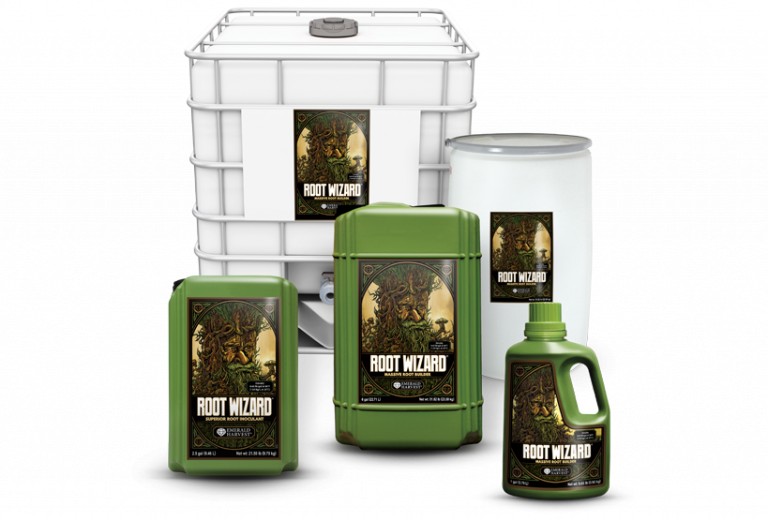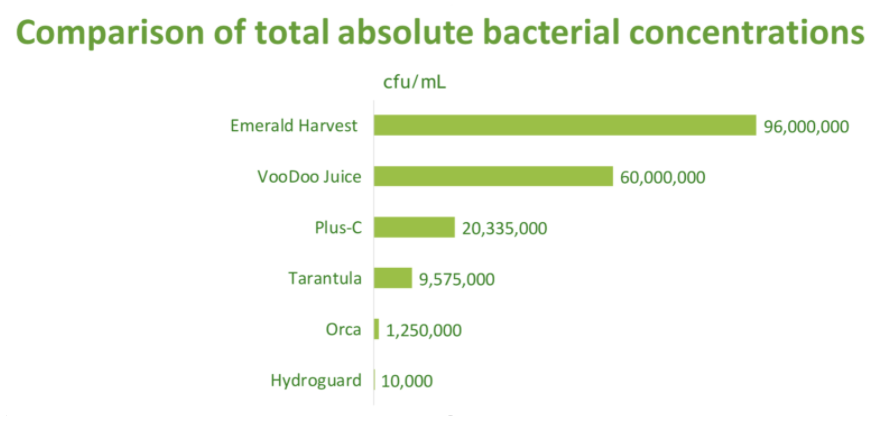ROOT WIZARD
1.
WHY USE ROOT WIZARD
MASSIVE ROOT BUILDER?

Root Wizard gets more nutes to your roots with just two easy applications during the crop life cycle and is suitable for soil or hydroponic gardens.
- Vibrant, stable rhizobacterial colonies in the root zone
- Bigger roots and longer root hairs for optimal nutrient uptake
- Clean root system for better hygiene in the growing medium
2.
WHAT MAKES IT WORK?
Any superior feeding program that aims to produce big, beautiful buds first needs to foster a large, healthy root system to take up nutrients.
Root Wizard increases the size and performance of roots for stronger, healthier, more prolific plants that take up more nutes.
Root Wizard’s potency as a root builder comes from the six species of beneficial bacteria it contains.
Beneficial microbes are absent from hydroponic gardens unless applied by growers. That’s why microbial inoculants are important.
Use Honey Chome with Root Wizard! Honey Chome has carbohydrate ingredients that feed the beneficial microbes to make them strong, prosperous and effective!

There are three main classes of beneficial bacteria.
Nitrogen-fixing bacteria contribute to the nitrogen cycle—the route that nitrogen takes as it moves through organisms and the environment, all the while changing forms.
Phosphate-solubilizing bacteria (PSBs) convert unavailable forms of phosphorus into bioavailable forms. Most of the phosphorus found in nature is locked up in rock and soil and unavailable to plant roots.
Plant growth-promoting rhizobacteria (PGPRs) colonize the rhizosphere, where they serve the dual purpose of defending the roots against harmful, invasive microbes and increasing root mass—and therefore uptake.
Increased root mass is partially a by-product of healthy roots, which a large, vibrant colony of PGPRs ensures. However, many PGPRs also produce phytohormones—plant hormones—which they release at the root tips, stimulating new root growth—and even heightened upper-plant growth and flowering
PGPRs assist in nutrient update by breaking down organic matter and converting it into bioavailable nutrients, which they deposit right at the root tips, where most nutrient uptake takes place.
What kinds of bacteria are in Root Wizard?
- Bacillus amyloliquefaciens – effective bacterial species for combating plant pathogens. It also synthesizes potent natural antibiotics, including fungicides and bacteriocins.
- Bacillus licheniformis – helps control harmful bacteria and fungi
- Bacillus subtilis – a root colonizer that forms cell arrangements or communities called “rafts” that swarm the rhizosphere
- Bacillus laevolacticus – lower the pH where they thrive, preventing other harmful microorganisms from colonizing
- Bacillus pasteurii – improves the strength of substrate or soil as well as the porosity and profile of that soil
- Paenibacillus azotofixans – increases plant growth and flowering by producing phytohormones, helping to chelate micronutrients and acting as a biological pest control
3.
WHY ROOT WIZARD
OVER THE COMPETITION?
- Applying the right species of rhizobacteria for the crops you grow, which Root Wizard does better than any other product.
- Applying them in sufficient concentrations to form viable, prolific, sustainable colonies in the rhizosphere, which Root Wizard also does—and better.

If you put all the spores in all the products listed above together they would not even add up to the equivalent total spores of Root Wizard!

ROOT WIZARD : 96,000,000
ALL THE REST: 91,293,000
In terms of value, you’re getting a lot more viable bacterial spores when you buy a bottle of Root Wizard than when you buy any of our major competitors.
4.
CAN I USE ROOT WIZARD WITH MY CURRENT NUTRIENT LINE?
It is possible to have great results using Root Wizard with another brand of nutrients and Root Wizard is a great entry product to introduce customers to the quality and performance of the Emerald Harvest line. But, like our other supplements, growers should use the full Emerald Harvest line as a complete plant nutrient system to maximize the genetic potential of their crop.

